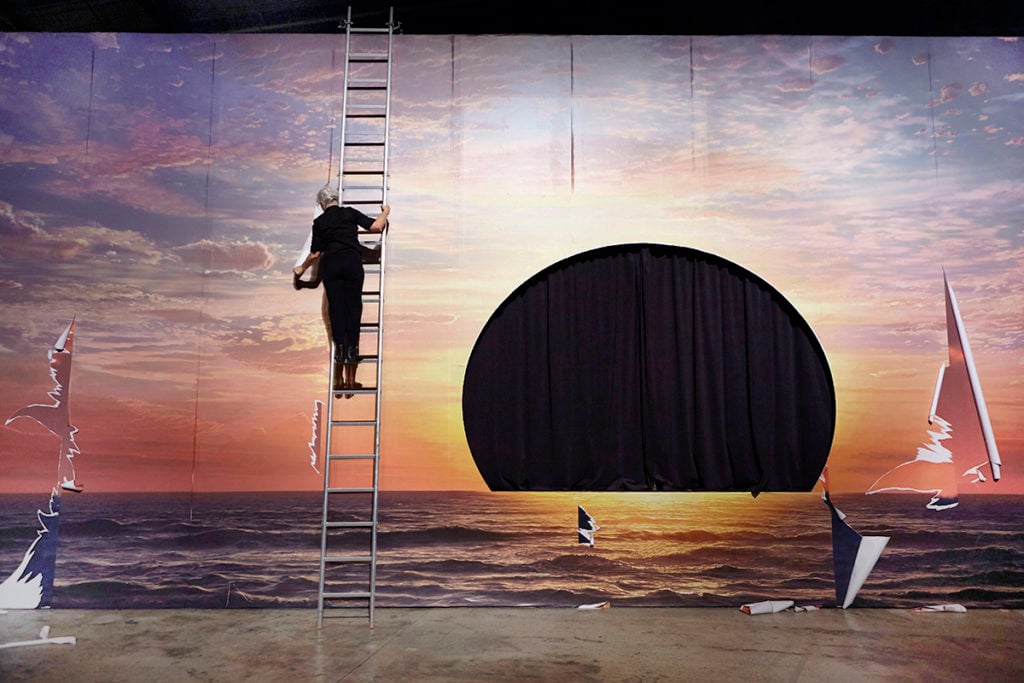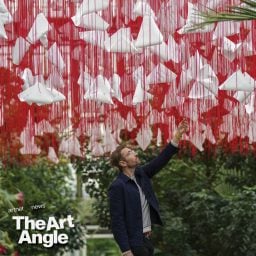This is part of the Biennial Artist Project, a series on the stars of the biennial circuit. You can also read profiles of the top 23 artists and our critic’s take on the phenomenon. The full list of biennial artists (and which galleries represent them) is available to Artnet News Pro members.
The art market has clear ways to measure success: sold-out booths at art fairs, rising auction prices, blue-chip gallery representation. But there is a parallel art world—the biennial circuit—that confers perhaps the ultimate prestige.
These ambitious group exhibitions, often organized by top curators, have proliferated in just about every corner of the globe, from Coventry to Kathmandu. So who are the in-demand figures defining these critical art conversations? And how much do they overlap with the art stars who typically draw headlines in publications like this one?
To find out, we counted. We examined a huge number of biennials and triennials—more than 200 of them—held since the last Documenta in 2017 to generate a list of the most widely exhibited artists. As it turns out, the names don’t correlate with art-market power rankings—not in the slightest.
There is almost no overlap between under-40 stars who made ripples at the recent New York auctions—painters like Anna Weyant and Lauren Quin—and the artists of the same generation who have emerged from the recent epoch of biennials, such as the multimedia artist Korakrit Arunanondchai, the conceptual artist Augustas Serapinas, and the sound artist Lawrence Abu Hamdan.
It is fascinating to see that the divide is so distinct between two interlocked arms of the same industry. The biennial circuit is fueled by its own system of demand, hype, and trends. It is a parallel universe with its own rules, hierarchies, challenges, and, crucially, its own economy.
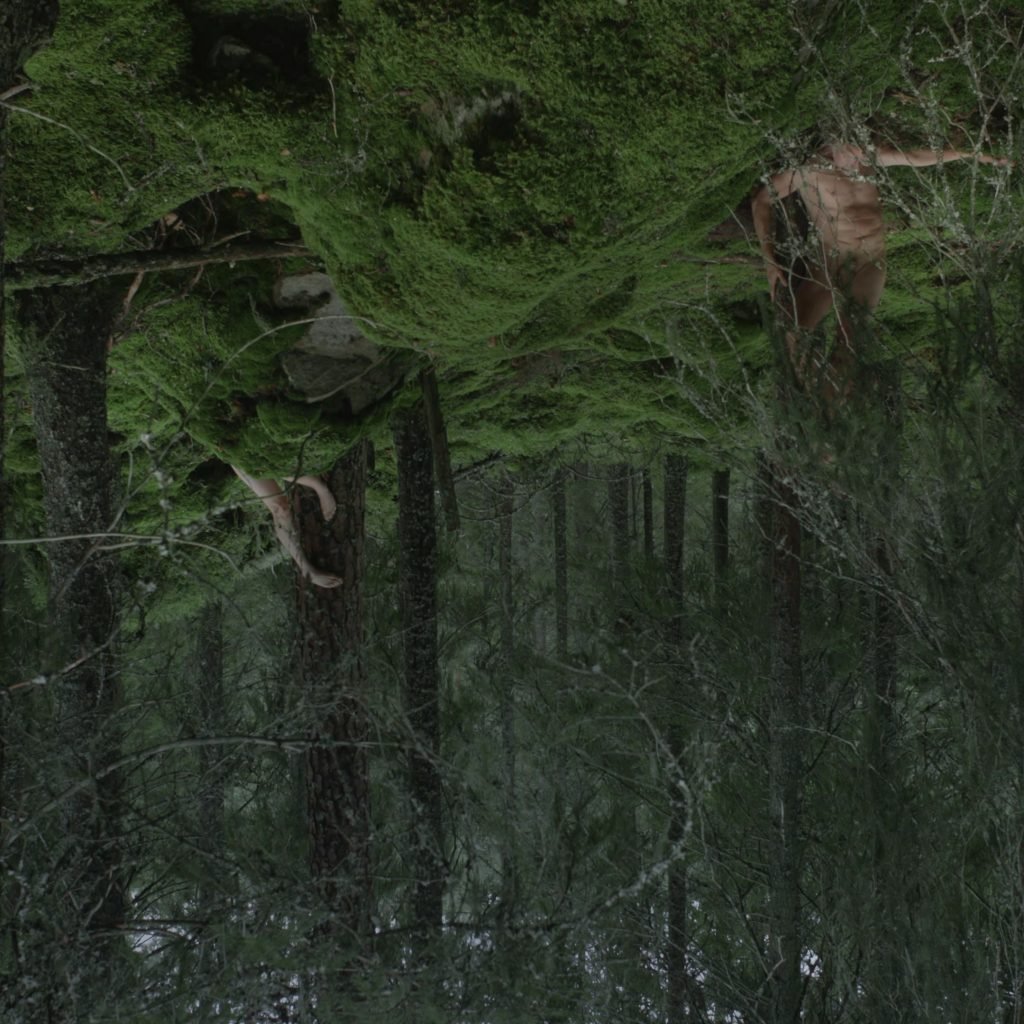
Zheng Bo, Le Sacre du printemps (Tandvärkstallen) (2021-22). Currently on view at the 59th Venice Biennale. Courtesy of the artist.
Two Worlds, Overlapping
When I called artist Zheng Bo, he was outside drawing a picture of a flower, a practice that he has maintained since 2020 amid participation in a worldwide circuit of biennials—ten in the past five years. He is the sixth most exhibited artist on our list after Arunanondchai, Uriel Orlow, Abu Hamdan, Superflex, and Chiharu Shiota.
Zheng doesn’t seem to care much about this accolade. After all, he lives and works in a forest just outside of Hong Kong; far, psychologically and geographically, from the art centers of New York and London. The forest is his muse and the main subject of his work, which considers the natural world through a queer lens. At this year’s Venice Biennale, his video Le Sacre du printemps (Tandvärkstallen) explores the erotic charge between plants and humans. (The relationship between people and nature is a major theme for many of this era’s biennial stars.)
“I am not an artist who depends on the market,” Zheng told Artnet News. His low-cost works, which he describes as “living projects,” simply don’t require much material beyond nude actors and naturally lit forest floors. He began working with a gallery, Kiang Malingue, for the first time in 2018. “I think they are the only gallery that has approached me,” he added with a laugh. “I don’t depend on the gallery but it is good to have the relationship, which is loose.” Asked if his work is ever presented at art fairs, he said he wasn’t sure.
The art market loves to express proximity to, and borrow discourse from, artists like Zheng, though the affection is not reciprocated. Of course, some biennials, such as the recently opened Venice Biennale, feature rising-star painters like Louise Bonnet and Jamian Juliano-Villani. Yet the biennial power players who topped our list generally have a disinterest, distrust, or dislike of the art market.
This is not entirely surprising given that their work is often highly political and skeptical of capitalism, neoliberalism, and Western approaches to cultural production. Art collective Forensic Architecture, which appeared in seven shows between 2017 and 2022, created a work for the 2019 Whitney Biennial that examined the museum’s now-former board member Warren Kanders’s teargas-manufacturing company. And Hito Steyerl, who appeared at six biennials between 2017 and 2019, frequently criticizes hyper-financialization and burgeoning technology in her videos.
Suffice it to say, many of these artists might not run into the arms of a market known for storing money for the world’s wealthiest.
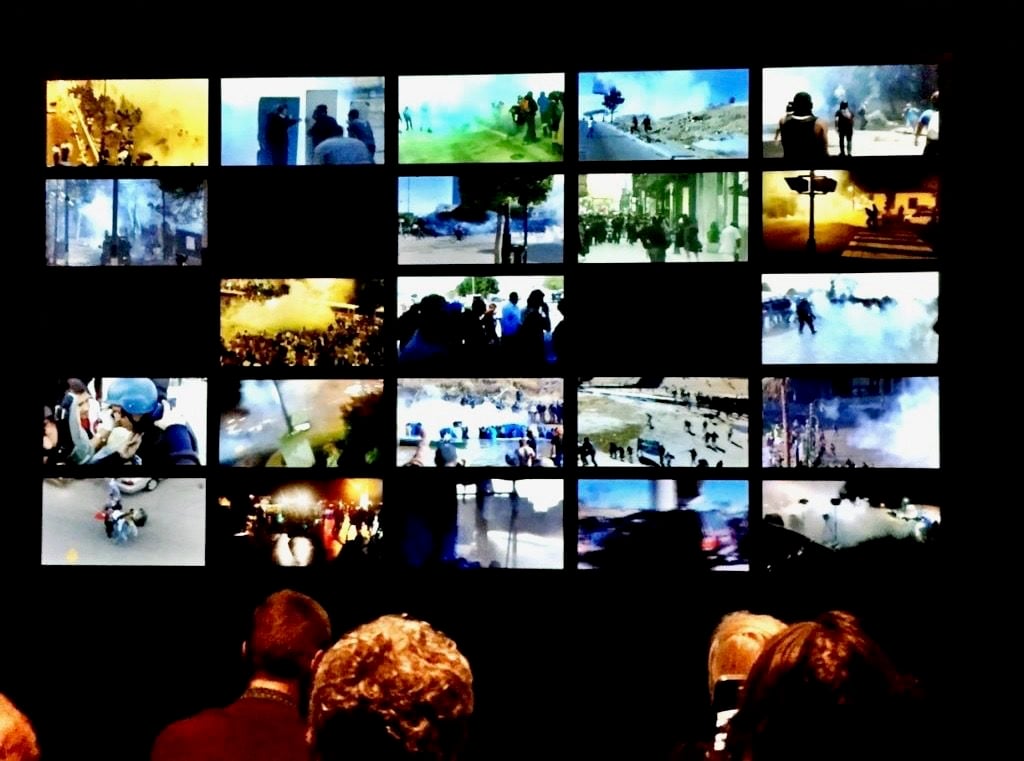
Forensic Architecture’s video project Triple-Chaser at the Whitney Biennial. Photo by Eileen Kinsella
On Form, Function, and Place
There is also the question of form. Ambitious installations and multi-channel video works are an ideal vessel for complex topics, which means they are a frequent presence at biennials—but they are also difficult to buy and sell.
“If I can be cynical, none of these artists is a painter,” Cecilia Alemani, the curator of this year’s much-lauded Venice Biennale, said after I rattled off some of the artists on our list. “How many times have you seen video works go to auction or sell for millions of dollars? Not often—actually, perhaps never.… They just run on two different tracks and two different fuels: one is money, the other is hopefully content and meaning.”
Paris-based Lebanese artist Ali Cherri, who describes the subject of his work as “geographies of violence,” addresses major political events through films that straddle the art and cinema worlds. His newest, The Dam, premiered at at Cannes, while a related three-channel video was shown at the Venice Biennale, where it won the Silver Lion for a promising young participant. Both films are set around the 2013 Sudanese revolution. The Dam tells the story of a man who goes to the desert to build a mysterious mud construction, which comes alive.
“If we want to change the world we live in, we have to be able to imagine a different world,” Cherri said. “Creativity is a political strategy.” He is not alone in this sentiment—intensive, investigative research into politics, violence, and oppression underpins many divergent practices of the artists on our list, from Cian Dayrit to Kapwani Kiwanga. And in that sense, it is not totally surprising that, while many artists are based in Western hubs like New York, Berlin, or Paris, they are often part of diasporas stemming from Asia, the Middle East, and Latin America, and scrutinize the impact of Western colonialism.
These are vital conversations, yet—both in form and content—they do not easily funnel into the art market. Defne Ayas, who co-curated the Gwangju Biennial last year, described the market and the biennial circuits as “almost different worlds in parallel play, with our discursive one definitely more endangered.” She lists the Karrabing Film Collective, an Australian group of filmmakers that interrogates the politics of inequality for Aboriginal peoples in the region, as an influential creative force (they’ve appeared in six biennials since 2017) with little structural support.
“These are not artists who produce some corporate plaza-pleasing abstractions that triple in value in every auction season,” Ayas said. “They are not artists who allow their work to be instrumentalized as financial tools.”
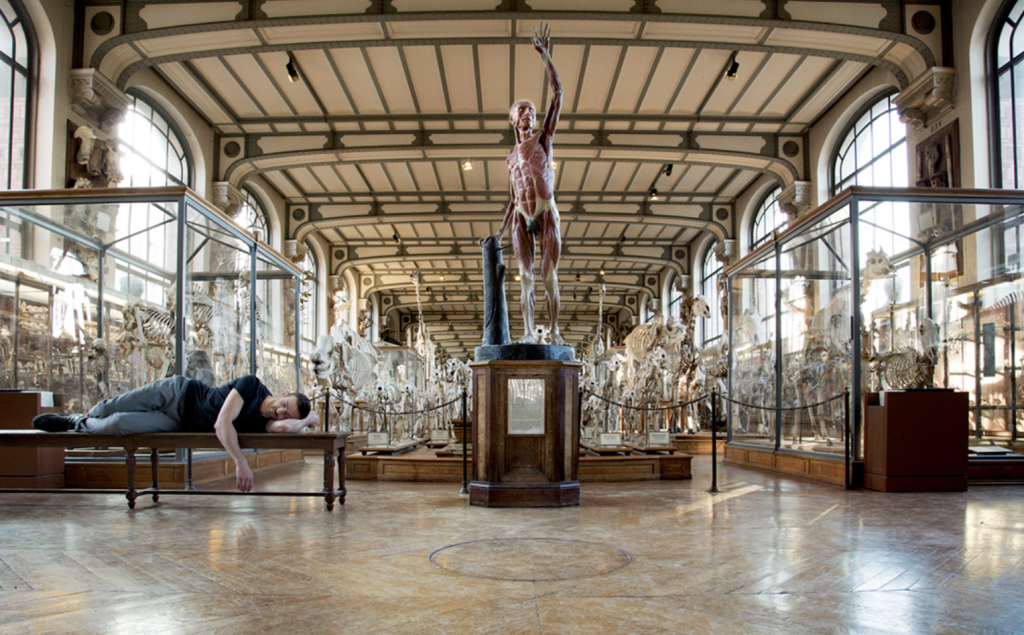
Still from Ali Cherri, Somniculus. Shown as part of The Economy of Living Things at the Jeu de Paume.
The Dealers of Critical Discourse
Many of these artists can’t afford to entirely cut ties with the art market, and some of them do eventually gain a collector base or enter into institutional collections. But this takes time. In the interim, many artists rely on a patchwork of government funding, public foundations, and private money—while bemoaning the fact that few biennials offer a fair fee to participate.
Ho Chi Minh City-based artist Tuan Andrew Nguyen is presenting work at four major biennials this summer alone, including two videos at the Berlin Biennale, which opens this week. His Manifesta 13 project was supported by the VIA Art Fund, a New York-based body that awarded $1 million in individual grants last year. The Sharjah Art Foundation (which has around $200,000 that gets broken up into individual grants) helped finance his projects for the 2019 Sharjah Architecture Triennial and Sharjah Biennial.
Though Nguyen has never received government funding (the Vietnamese government is unsupportive of the arts in general, but especially of artists who don’t toe the party line), those in Europe have more access. Many of the top artists on our list—a total of 13—are based in the German capital of Berlin, which is surely no coincidence: In 2022, Germany’s budget for culture is $2.4 billion, with artist grant money distributed by local governments.
To offer a bridge between grants in the absence of production fees (the Venice Biennale is notorious for offering no fees and very little support in terms of shipping and production), dealers are frequently called in for help.
Nguyen’s dealer, James Cohan in New York, has been a major supporter. The gallery is supporting part of his installation costs for the Berlin Biennale, and are regular co-producers of other works by the artist that have ended up in biennials. “It would [otherwise] be difficult to even participate in some of these biennials, especially in some of the European ones that ask the artists to fund their own installation and shipping costs,” Nguyen said.
Some dealers have come to specialize in this kind of ambitious programming and the art dealing that comes with it, seeing it as its own kind of calling. Andrée Sfeir-Semler represents biennial frequent fliers Lawrence Abu Hamdan, Rayyane Tabet, and Dineo Seshee Bopape, and helped produce Abu Hamdan’s contribution to the Berlin Biennale.
“Money has never interested me really—we need it, but it is not our aim,” Sfeir-Semler told Artnet News. “I am interested in bright, intelligent artists who are very conceptual, who have something to say about society.”
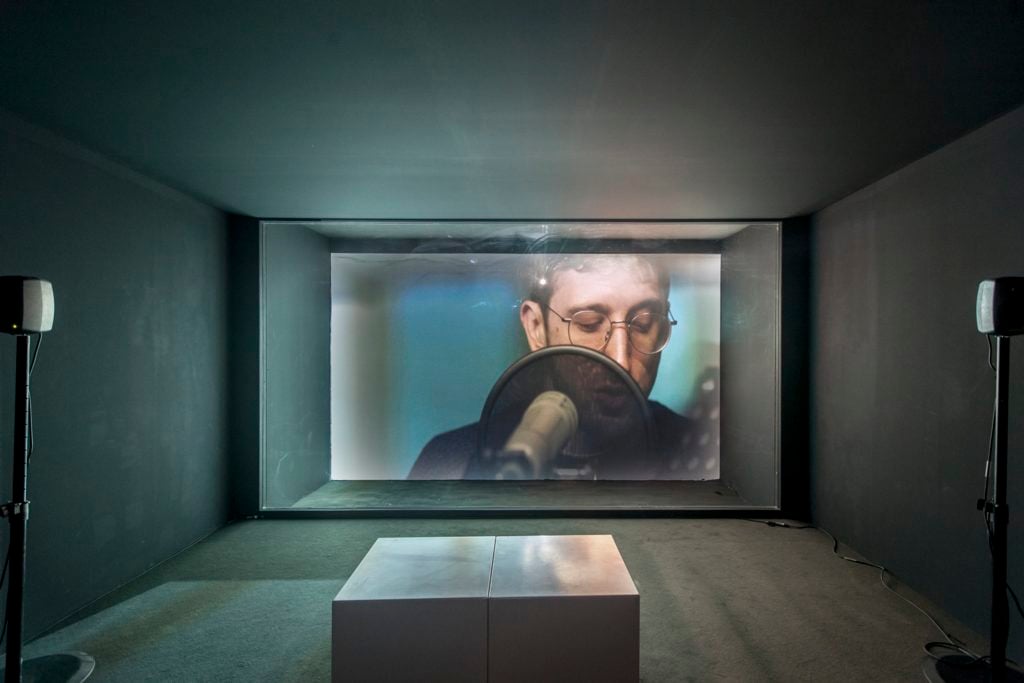
Lawrence Abu Hamdan, “Walled Unwalled” (2018). Courtesy of Photo Solutions.
Such a heavy investment must be baked into the business model. And it’s not as simple as selling a canvas off the wall and adjusting the prices up after similar works break records at auction.
“We price works not depending on the market or demand but on the biennials they did, the institutional shows and collections they are in,” said Alex Mor of the Paris- and Bogota-based gallery Mor Charpentier, which represents Abu Hamdan, Urlow, Kader Attia, and Marwa Arsanios. “Seeing a price of a painting shoot up from $5,000 to $200,000 in a year—this is quite dangerous and does not make much sense to us.”
Still, these dealers are betting that their artists will become part of art history in a way that the flavor of the month might not. Think of it like a slow-growing mutual fund versus a pump and dump stock scheme. “It is not the kind of art that you sell immediately,” Mor said. “You need people to come over and see the work to understand it, and it may take years to have people wrap their head around the work. With paintings, it’s a no-brainer.”
Mor has represented Abu Hamdan since 2014, back when he was followed by just a small group of curators. Today, he has a strong market—but his main collector base is still museums, which, due to bureaucracy, are slower to buy (from agreement to payment, the process can take more than a year).
The broader collecting public, Mor observes, has in some ways become less adventurous in recent years, and video and installation are more difficult than ever to sell. “Some of the collectors who used to be fiercely interested in conceptual practices, nowadays are interested in figurative painting and things that are easier to see and store,” he said.
Despite these headwinds, he remains undeterred. “We are working on the long term, it takes time and you have to be patient. We are not criticizing the other way, it exists and it is okay. But for galleries like us, the system is different.”
Imane Fares, who represents Cherri and Alia Farid, says she frequently transfers money from her construction business to keep her artists solvent. She estimates that 80 percent of her sales go to institutions. Work by Ali Cherri, for example, was recently acquired by the Pompidou, London’s National Gallery, Guggenheim Abu Dhabi, and the Sharjah Art Foundation.

Processional performance with Thembekile Komani and Aphiwe Mpahleni Mohau Modisakeng, Land of Zani (2019). Courtesy of Sharjah Art Foundation.
Better Support Is Critical
Conversations with players on all sides of the biennial system reveal that the status quo has not conferred adequate support. A few artists, speaking off the record, said fees from biennials were barely enough to stay afloat—European biennials and a few Asian biennials expect artists to foot the bill even for their own installation and shipping costs.
One artist estimated a sustainable fee to create new work that can take up to two years would be $10,000 to $15,000. But that is far from typical: The Whitney Biennial, as journalist Javier Pes and I wrote about in an article in 2019 about biennial economies, now pays an increased fee of $1,500 to make a new work. Other shows offer just a few hundred bucks, or nothing at all.
“This is something that frustrates me all the time, though I have had to come to peace with it,” said Korakrit Arunanondchai, who has participated in 14 biennials in the past five years alone. For the Kathmandu Triennial this year, which has a smaller budget than some shows, he was happy to reinstall an older work for a modest fee.
“I spend what feels like half of my career showing in biennials, which is a privilege—but having to feel like it is a privilege and therefore spend my own money or exploit my own resources to make it happen, that feels just wrong,” he says.
Part of the problem, Alon Schwabe from the artistic duo Cooking Sections notes, is that biennials operate on the assumption that inclusion will help artists sell work—but the obvious gulf between the market and these international exhibitions makes this assumption flawed.
“We have had to be very imaginative and agile in finding ways to fund our projects,” he said. Because Cooking Sections is not represented by a gallery, it relies on grants and public funding from inside and outside the art world, sometimes working with universities and scientists.
Ayas notes that there is a small but dedicated collector base that steps in to support many of these artists’ efforts—but this part of the ecosystem remains rare and fragile. “These collectors engage as supporters and patrons; they can engage as co-commissioners,” she said. “They are not in the art world to hide their money in something. They don’t like to lose either, but for them the kick is in the engagement.”
Perhaps biennials need to cut back, in number but also in scale, to make sure that each star coming out of the system is adequately supported. Prestige is not a wage. “We don’t want to end up in a situation where museums just show painters because that is the only economy that works,” Arunanondchai said.
Curator Alemani agrees that cultural institutions need to better “foster critical understanding and intellectual values” irrespective of marketability. But the path forward is not clear. “In the end,” she said, “I still hope that art history is made by museums and cultural institutions and not the market.”
Follow Artnet News on Facebook:
Want to stay ahead of the art world? Subscribe to our newsletter to get the breaking news, eye-opening interviews, and incisive critical takes that drive the conversation forward.
